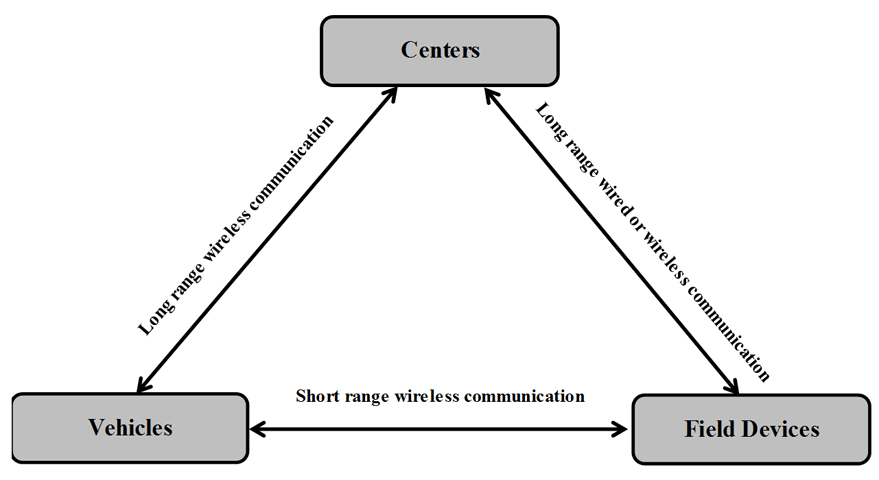
Road Network Operations
& Intelligent Transport Systems
A guide for practitioners!

Road Network Operations
& Intelligent Transport Systems
A guide for practitioners!
ITS works when the supporting infrastructure – which includes roads, ITS devices, vehicles, terminals, management centres – communicate with each other and with users. For a road authority, the ITS infrastructure components can be divided into four different categories: field, centre, vehicle and telecommunications.
The diagram below shows how field, centre and vehicle infrastructures connect to each other. Centres may communicate with each other and with field devices through wired or wireless technology. Vehicles communicate with centres and field devices through wireless infrastructure.

ITS Architecture plays an important part in Road Network Operations. The ITS architecture is a primary element in ITS planning. Two types of ITS architecture are typically defined:
A high level ITS architecture provides the framework for the deployment of ITS across a wide geographical area with multiple jurisdictions and different stakeholders participating in common or inter-dependant operations. The architecture specifies how the various ITS components interact with each other to address the transport problems. It provides the basis for planning, designing, deploying, maintaining and integrating systems to realise transport objectives.
An ITS architecture does not specify the ITS scheme design in detail. Nor does it require a particular design approach. Instead it does the important job of specifying the performance criteria that the system components must satisfy – and defines a general framework from which several alternative designs or design options may be developed. These distinct designs will conform to the common ITS architecture. (See What is ITS Architecture?)
An ITS architecture should define the following:
Maximum benefit from ITS requires interoperability and interchangeability of systems between regions and within a region. Interoperability refers to the condition where different types of systems can interface with each other to meet the system’s functional requirements. Multiple brands of a device on the same communications channel is an example of interchangeability. One of the primary goals of ITS is to integrate a variety of previously independent systems to minimize redundancy and maximize efficiency – so adhering to ITS and other industry standards will satisfy the interoperability and interchangeability requirements and support future efficient system expansion. Legislative requirements to comply with industry and ITS standards in any ITS project will support interoperability, interchangeability and future cost-effective expandability of the system. (See ITS Standards)
Technology is changing at a rapid pace and this trend is expected to continue indefinitely. ITS builds on technology-based services – and the pace of technological change is an important consideration in planning and deployment. Three issues must be addressed when considering changes in technology for any ITS applications. These are: upgrade, legacy systems and systems integration.
With technology changing rapidly, even during the course of an ITS project, it is important to anticipate the possibility of system upgrades. Newer technologies can improve the performance of an already deployed system – and may require a decision on whether to upgrade the system or replace it. Where it is possible to look ahead, work planning and design should allow for the possibility of upgrades so they can be accommodated efficiently and without technical complexity. A possible disadvantage is that system upgrades may require highly skilled professionals to operate and manage the new systems in the future.
As new systems and upgrades come on line, they must be integrated with earlier “legacy” systems. The challenge lies in making the new systems interoperable. ITS architecture can show where and how established legacy systems will need to interface with new systems to deliver the desired (integrated) system functionalities and performance. A field evaluation plan for testing the interoperability between a legacy system and new systems will provide the basis for testing the integrated system after deployment.
Systems integration is about how different systems are connected together so that they can perform the desired tasks in an optimal way. ITS requires different types of hardware and software (which may come from different manufacturers and be implemented at different times) to be integrated to satisfy user requirements.
Problems – that can pose a significant challenge to systems integration – technically and because of the cost, are:
Adhering to established industry and ITS standards and the use of open architecture will support future cost-effective systems integration.
A system-wide outlook at the inception of a project will help develop a deployment plan that supports a cost-effective implementation strategy:
If the design provides for interchangeability of components it will encourage competition and allow scope for future improvements in cost, design, functionality and safety (See ITS Architecture):
ITS architecture can show where standard interfaces will bring significant benefits:
ITS architecture shows how different stakeholders are connected with one another through data exchange:
The existence of an ITS architecture can assist in integrating systems coming on-line in different phases:
ITS architecture can support security services related to disaster response and evacuation, freight and commercial vehicles, hazardous materials, rail, transit and transport infrastructure:
Bloomington/Monroe County USA, Regional Intelligent Transportation Systems Architecture, 2008.
Chowdhury, M. and Sadek, A., Fundamentals on Intelligent Transportation Systems Planning, Artech House, Boston, MA, 2003.
Fries, Chowdhury and Brummond, Transportation Infrastructure Security Utilizing ITS, John Wiley & Sons, 2008.
U.S. Department of Transportation, National ITS Architecture, www.iteris.com/itsarch (accessed on December 1, 2013).